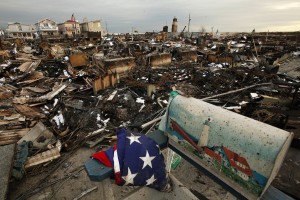Natural Disasters Take Social Media by Storm
November 12, 2012

For everything that happens in our world, there is a Twitter page, a Facebook page, a dedicated Tumblr blog and various Internet memes that will be associated — all within mere hours, and sometimes minutes, of said occurrence. These fan pages are created to poke fun at situations and get the public to respond. Though horrific, this also rings true to tragedies, not just light-hearted comical situations.
Most recently, we’ve been able to see these reactions with natural disasters, namely our most recent “Frankenstorm,” Hurricane Sandy. As Sandy approached and literally took us all by storm, memes of 1978’s “Grease” lead character of the same name, and the moon-suit wearing squirrel Sandy Cheeks from Nicktoon “Spongebob Squarepants” were seen across all social media outlets.
Before the storm had even hit, Tumblr and Twitter users alike were already preparing for the disaster by bringing about clever jokes and laughter as the calm before the storm. The most popular images were the evolution of Hurricane Sandy’s path tracked by The Weather Channel being replaced by Sandy’s evolution in “Grease” from innocent, goody-two-shoes new girl on Thursday morning to cigarette-smoking, leather-wearing badass as the storm reached Monday morning, and an angry Sandy Cheeks in the eye of the storm, as seen in “Survival of the Idiots,” where she is woken early from her hibernation and goes on attack.
Admittedly, I laughed at some of these memes. But it wasn’t long before I caught myself laughing and felt extremely uncomfortable with many of the jokes I was reading. The disaster at hand was not being taken seriously. People were fearful of their lives and homes, praying they’d have electricity, heat, clothing and food by the end, and here were those of us lucky enough to have Internet access making a joke of it all.
Aside from these visual puns, Twitter exploded with “humorous” tweets about Hurricane Sandy. If one searched through the storm’s hashtag, they could find tweets such as “@Lord_Voldemort7: ‘Is this hurricane a boy or a girl?’ #AwkwardQuestions #HurricaneSandy #AmbiguousNames,” and a whole satirical Twitter account for the Frankenstorm herself, @AHurricaneSandy, which bred over 235,000 followers, with her first tweet being posted on Friday, Oct. 26th, tweeting things such as, “RETWEET IF U WANT ME 2 DESTROY YO SCHOOL. I GOT YOU,” and “JUST BLEW DA ROOF OFF A OLIVE GARDEN FREE BREADSTICKS FOR EVERYONE.”
Closer to home for those of us at Fordham College at Lincoln Center (FCLC), a separate Twitter account was made solely for the crane on 57th Street and 7th Avenue, @One57Crane, though this account was far less popular than @AHurricaneSandy, boasting only just over 200 followers. Even so, these hurricane parodies became “Internet famous” in a very rapid time period.
From these accounts, we can see that bloggers are (or rather, are attempting to) make light of the situation, but are not taking it seriously at all. Natural disasters are nothing to laugh about. Communities are destroyed and many are injured or even killed. These “meme-sters” and bloggers are being insensitive and do not understand the gravity of the situation. Furthermore, making such outright jokes and statements online make it seem like it is okay to do so for others, and so the trend grows and grows until it is a larger than life phenomenon.
I am a resident at FCLC’s McMahon Hall, where I was blessed to have heat, hot water, electricity and safety during the storm. However, my hometown was not so lucky. I come from Lindenhurst, located on Long Island’s south shore in Suffolk County. The National Guard declared the area as being in a “state of devastation.” As I scrolled through Twitter and Instagram in the days following the storm, I saw my childhood friends post pictures of the Great South Bay extended over land and taking over half of the highway, their houses demolished, cars smashed by trees and lives ultimately ruined. Many fires started because of power lines that had gone down, and the roads were so flooded that the fire department could not even reach many of these fires.
Aside from the damage Mother Nature brought upon Lindenhurst, many have to worry about looters stealing anything salvageable from the debris of where their homes once stood. CNN showed footage of families being kayaked to their homes to see what could be saved because flooding was so bad. The hardest part of this was knowing I wasn’t home to do anything. People of the Internet laughed at the tasteless jokes left in Sandy’s midst, as I prayed for my family and friends back home. I wasn’t laughing, but instead trying to imagine how my town would even begin to reconstruct what had been.
Like my hometown, many towns were left looking more like abandoned war zones and battle grounds than places people actually lived. With this comes injury, loss, and heartbreak – nothing to crack jokes about. Yes, these memes are all in good fun, but when people’s lives and livelihoods are at risk, there is a line that can’t be crossed. Once something is posted on the Internet, you can never get it back — especially if it goes viral as Hurricane Sandy’s memes had. In the end, though these memes are only “jokes,” they are simply in poor taste, and may offend more than entertain.








